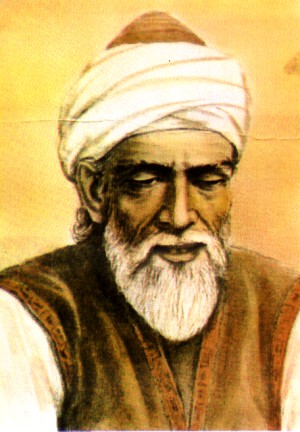
Abu al-Wafa’ al-Buzjani (940 – 998)
On June 10, 940, Persian mathematician and astronomer Abū al-Wafāʾ, Muḥammad ibn Muḥammad ibn Yaḥyā ibn Ismāʿīl ibn al-ʿAbbās al-Būzjānī was born. Abu l-Wafa wrote several books on applied mathematics, made several important trigonometric discoveries, and wrote now-lost commentaries on the works of Euclid, Diophantus of Alexandria, and al-Chwarizmi. His work on arithmetics for businessmen contains the first instance of using negative numbers in a medieval Islamic text.
Abu al-Wafa – Biographical Background
Abu’l-Wafa grew up at the time of the Buyid dynasty‘s rise to power (ruled western Iran and Iraq from 945 to 1055), and at the time of their heyday he worked under the regency of Adud ad-Daula (r. 949-983). The latter was a great patron of the arts and sciences and, in addition to Abu’l-Wafa, attracted other outstanding scholars, such as the mathematicians Abu Sahl al-Quhi and as-Sijzi, to his court in Baghdad. Also under his son, the following Emir Sharaf ad-Daula, al-Wafa worked in Baghdad and was involved there alongside al-Quhi in the observatory, which was completed in 988. Among the instruments were a quadrant more than 6 meters long and a stone sextant more than 18 meters long. This enabled Abu l-Wafa to determine the inclination of the ecliptic, the length of the seasons, and the longitude of Baghdad, among many other astronomical observations. However, after the death of Sharaf ad-Daula, the observatory was promptly closed. Al-Wafa also collaborated with al-Bīrūnī [1] in Khorezmia to more accurately determine the difference in longitude between the two locations from the simultaneous observation of the lunar eclipse on May 24, 997. Contrary to occasional claims, however, he did not discover the irregularities of the moon’s orbit.
Trigonometry and the Study of the Moon’s Orbit
Abu l-Wafa is known for the first use of the tangent function, and for producing tables for the six trigonometric functions at 15′ intervals (equivalent to a quarter of a degree). The values given are accurate to eight decimal places (for comparison, Ptolemy‘s values were accurate to only three decimal places). He also introduced the secant and cosecant functions and anticipated modern mathematical developments when he proposed defining trigonometric functions in terms of the unit circle. These elaborations were made by al-Wafa as part of his study of the orbit of the moon.
A Textbook on Applied Mathematics
In the years after 961, al-Wafa composed a mathematics textbook for scribes and businessmen, the Kitāb fī mā yaḥtaǧ ilayhi al-kuttāb waʾl-ʿummāl min ʿilm al-ḥisāb (“Book on what is necessary to know from the science of arithmetic, for scribes and businessmen“). Although al-Wafa was an expert in the use of Indian numerals, in this book he wrote out all the numbers in words, so the calculations must be followed in the mind. This was quite common at that time, since among the addressed circle of people the use of the Indian numerals, with us today mostly called Arabic numerals, was still not in use for a long time. Of particular interest is the reference to negative numbers in Part II of Abu’l-Wafa’s treatise. This seems to be the only place that negative numbers have been found in medieval Arabic mathematics. Abu’l-Wafa gives a general rule and gives a special case of this where subtraction of 5 from 3 gives a “debt” of 2. He then multiples this by 10 to obtain a “debt” of 20, which when added to (10 – 3)(10 – 5) = 35 gives the product of 3 and 5, namely 15.[2]
Further Mathematical Contributions
Al-Wafa wrote another application book for the practitioner after 990, the Kitāb fī mā yaḥtaǧ ilayhi aṣ-ṣāniʿ min al-aʿmāl al-handasiyya (“Book on what is necessary to know of geometrical constructions for craftsmen“). Among many other things, it deals with the construction of right angles, construction of parabolas, and regular polygons. Thereby al-Wafa tries to make do with a ruler and (a fixed) compass. For problems that cannot be solved by construction, such as the trisection of the angle, which is one of the classical problems of ancient mathematics, he gives constructions with other aids, such as neusis constructions and compasses with fixed radius settings. For the construction of the regular heptagon, he gives only one (very good) approximate solution. Furthermore, al-Wafa simplified the ancient methods of spherical trigonometry and proved the sine law for general spherical triangles.
Simplifying Ptolemy
In another work, the Kitab al-Kamil (Complete Book), al-Wafa presents a simplified version of Ptolemy’s Almagest, from which many later astronomers took the observation data and used them for their own calculations.
Lianor da Costa, Overview of Medieval Mathematics, [8]
References and further Reading:
- [1] Al-Biruni – Mathematician, Astronomer and Founder of Indology, SciHi Blog
- [2] O’Connor, John J.; Robertson, Edmund F., “Mohammad Abu’l-Wafa Al-Buzjani”, MacTutor History of Mathematics archive, University of St Andrews
- [3] Hashemipour, Behnaz (2007). “Būzjānī: Abū al‐Wafāʾ Muḥammad ibn Muḥammad ibn Yaḥyā al‐Būzjānī”. In Thomas Hockey; et al. (eds.). The Biographical Encyclopedia of Astronomers. New York: Springer. pp. 188–9.
- [4] Youschkevitch, A.P. (1970). “Abū’l-Wafāʾ Al-Būzjānī, Muḥammad Ibn Muḥammad Ibn Yaḥyā Ibn Ismāʿīl Ibn Al-ʿAbbās”. Dictionary of Scientific Biography. Vol. 1. New York: Charles Scribner’s Sons. pp. 39–43.
- [5] E S Kennedy, M Mawaldi, Abu al-Wafa’ and the Heron theorems, J. Hist. Arabic Sci. 3 (1) (1979), 19–30.
- [6] S A Krasnova, Remarks on the treatise of Abu al-Wafa’ (Russian), Phys. Math. Sci. in the East ‘Nauka’ (Moscow, 1966), 131–140.
- [7] Abu al-Wafa at Wikidata
- [8] Lianor da Costa, Overview of Medieval Mathematics, KingdomofArtemisia @ youtube
- [9] Timeline of Medieval Persian Astronomers, via Wikidata and DBpedia





